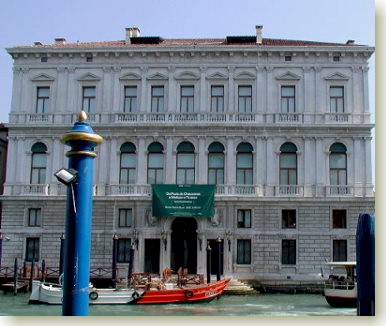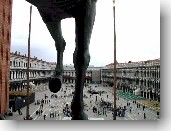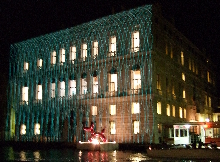|


| |
|

Palazzo Grassi
On our first few visits to Venice,
we were stunned at the magnificence of the palaces that line the Grand
Canal. We adored admiring their fading
façades by sitting on the stern of the
accelerato,
the Venetian name for the Number One line of the water buses - which are
called vaporetti, after the
Italian word for steam, vapore, the original means of propelling the
boats.
Not
being schooled in the details of historical architecture, the
distinction between buildings from the 14th or 16th Centuries alluded
us, and we certainly couldn't tell a Gothic building from Renaissance
one. So this little page is intended to help the person on their
first visit to Venice get the most out of viewing
these magnificent palaces. It is not at all an in-depth study,
just a quick reference guide to put things in perspective so that you
will know a little bit about the history and origin of these buildings.
More detail is contained in the mouse-over notes.

The Venetian
Republic was one of the most powerful City-States
in the world for 700 years
from the 11th through the 17th Centuries.
The history of this power and splendor can be
traced
in the palaces that still line its canals.
There is no place in the world
like Venicewith the number and
magnificence of grand palaces. Rome, Florence and Milan – all huge
past world powers – have 6 to 8 major palaces each.
Venice has
almost 100 palaces!
The most important address in Venice has always
been the Grand Canal
– the major waterway that snakes through
the city. It is natural, therefore, for the most glorious palaces to
be on the Grand Canal.
By ancient law, only one palace was allowed to
carry the title Palace (Palazzo) – and that is the Doges’s
Palace (Palazzo Ducale), the home of the head of the
Venetian state. All other palaces had to be called simply House (Ca’
– short for Casa).
Today, most of these magnificent building carry the title Palazzo,
but there still are some huge and very famous
palaces with humble names like Ca’Rezzonico & Ca’d’Oro.
|

Piazza San Marco |
Another interesting law states only one plaza is
allowed to carry the name Plaza (Piazza) and that is the huge
and beautiful Piazza San Marco
in front of the Doge’s Palace and the Doge’s Church,
San Marco. All other plazas had to be called simply
Campo, meaning field, even though these “fields” have been paved
over for centuries.
The front of a Venetian palace always faces
the water because that was the way one approached it – by boat.
Venice’s canals are its streets. The backs of the palaces face the
campos behind them and are not elaborately decorated like the water
sides.
These houses were owned by the
merchant
nobility who were the driving force in the Venetian economy
and the rulers of the Republic.
These palaces served as both homes and
businesses,
the trading headquarters for their business. The ground floors
acted as warehouses
(the fondaco) to store the goods
the family traded in distant lands with their fleets of ships.
The wide and deep Grand Canal made it ideal for delivering goods in
large ships right to the palace-warehouse.
By taking the
accelerato along the Grand Canal it is possible to trace the history of this
magnificent city in the design of its palaces.
Enjoy the ride. Click on the pictures for a
better view.

Byzantine Palaces
The
Byzantine palaces were the first of the grand palaces and were built from the
5th to
almost the 13th Century.
There are
still a few examples intact today,
but most have become much modified and "updated" to Gothic or
Renaissance styles by previous owners .
Byzantine palaces are caricaturized by very graceful
rounded top columns that face the windows of the main floor, generally
running the entire width of the building, and face a
gallery on the ground floor that was used to unload goods from the
ships. These palaces also had beautifully decorated facades.
This example, the lovely Palazzo Corner Loredan near the Rialto Bridge, was completed in 1362. The upper
two floors were added later, but it is
still a stunning
example of this very early architecture.
Check-out the detail showing typical Byzantine Arches which are very
graceful and elegant.
This building today is
Venice's Town Hall. |
|
|
|
 |
Gothic Palaces
The
beautiful Gothic palaces were built in the
14th and 15th
Century.
The style of these building is very particular to
Venice and is, in fact, called
Venetian Gothic. In the rest of the
Europe,
Gothic buildings are bulky, stone fortresses
that were necessary to protect the owners from the warring
neighbors in the Middle Ages. In Venice, where
the water protected them from attack, they are open and airy and
among the most stunning structures in the world.
There are many
of these palaces still in Venice.
You can easily identify them by there characteristic ogival
arches - the pointed top arches, which are, in fact, today
called Venetian Arches. It was very common to decorate the
spaces between or above these arches with round lacy cutouts in
stone called quatrefoils.
Take a careful look at the two arcades of
windows of the piani nobili to see their beautifully
nuanced differences of the
fenestrations.
Palazzo Pisani's
façade stands today virtually unaltered from
its original construction, and it is one of the few palaces still occupied
by the descendants of the original owners.
Palazzo Pisani is still today privately owned by descendants of the
Pisani family. If we could choose to
see the interior of only one privately owned palace, this would be it,
with it's sumptuous decoration and original Murano glass chandeliers
which have never been wired for electricity.
|
|
 |
Renaissance Palaces
Renaissance architecture came late to Venice. Most of the
great Venetian palaces were built in the
16th Century
and date from the apex of Venetian power.
They are beautiful
incarnations of the then ideal of emulating classical (ancient
Roman and Greek) forms.
These buildings reached monumental
proportions attesting to the great wealth of their owners.
In addition to the references to
classical forms, they are characterized by perfect symmetry.
A
frequent element of these palaces is the Palladian Window, seen here on the second and third floor and echoed
in the water entrance.
In the example we see here, there are two
large obelisks on the roof that were decorations granted by the
Venetian Republic for the homes of the capitani da mare -
the sea captains who lead the Venetian navy.
The
Palazzo Coccina Tiepolo is used today by the University of
Venice. |
|
 |
Baroque Palaces
Baroque
palaces are really a progression of the Renaissance style in
which zealous decoration took over the design. There were built
mostly in the 17th Century
during the beginning of
Venice’s decline.
There are massive structures with some of the
same characteristics as Renaissance palaces but with extensive
ornamentation and a much more imposing
felling of grandeur, but still with a feeling of order and
symmetry.
By now
the use of these buildings as palazzo-fontego
(home/warehouse) had vanished and they became ostentatious
centers for social life and entertaining.
Ca'Rezzonico shown here is today a wonderful museum fitted on
the inside with rooms decorated as they were at the height of
the 17th Century. |
|
|
 |
| Neoclassic Palace -
Palazzo Grassi
Postscript: The last great palace to
be built in Venice was Palazzo Grassi, pictured at the top
of this page. It was built in 1766 just as the Venetian
Republic was collapsing and Napolean came marching in.
It stands alone in Venice
as a majestic example of Neoclassic architecture. It is
instructive that it turned its back on the highly decorative
elements of the Baroque and returned to the harmonious elements
of classical architecture, reflected in the early
Renaissance. It lead the trend in Neoclassic architecture
that lasted through the beginning of the 20th Century and became
the backbone of the monumental civic building of Washington D.C.
and most of the world's great cities.
This palace was purchased
in 1984 by the Fiat car company and beautifully restored by the
famous architect Gae Aulenit. On our first trip to Venice
in 1987, almost all of the other great palaces were like great
old dowagers wearing dirty, tattered ball gowns with their torn
ruffles in the water. You could only imagine what they looked
like in their youth. PalazzoGrassi stood out like a shining, magnificent example of
what the entire Grand Canal once must have looked like.
An inspiring treat over
that past decades has been to watch as the great palaces have
been restored. One-by-one returned to beauty and splendor.
I don't know who has been buying them and spending the millions
necessary to rehabilitate them, but we are forever thankful.
In 2005 Fiat ran
into financial difficulty & had to sell the great Palazzo Grassi.
It was picked-up by the Casino di Venezia - which means the city
owned it. Alas, in April of 2005 the super wealthy Frenchman
Francois Pinault purchased an 80% stake
in the building. It will become the principal home for his
immense art collection, much to the scandal in Paris.
Pinaualt has entrusted the interior reconstruction to Takao
Ando. The Japanese architect has decided on a radical change,
demolishing the permanent mountings that Gae Aulent mounted
twenty years ago and which used light-colored surfaces made of
reinforced plaster separated from the original 18th-Century
walls. '
|
|
In the Spring of 2007 we returned
to Venice with our grandson Dietrich and we stunned one evening as our
vaporetto turned the corner on the Grand Canal and in front of us was
Palazzo Grassi's façade completely encased in a spider web of blue
lights. Pinauat had obviously opened his museum. Although a bit
jarring and not all what we expect in Venice, it was beautiful.
And out front on a raft guarding the palazzo was a heroic Jeff Koons
sculpture Balloon Dog - Magenta. Somehow it all worked.
|
|

Palazzo Grazzi wth Spider Web
Lights |
|

|
All
text and photos © Copyright Howard Case 2005
|